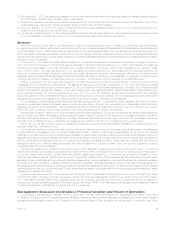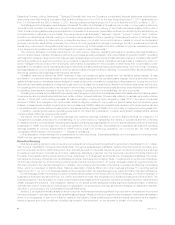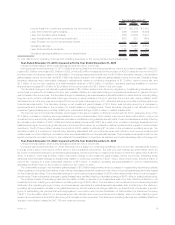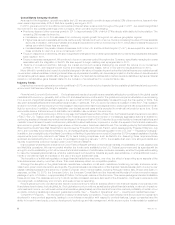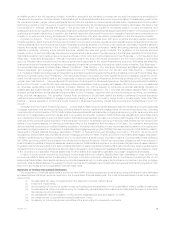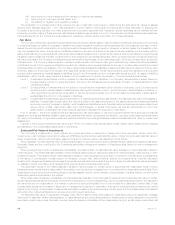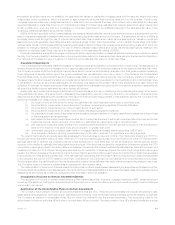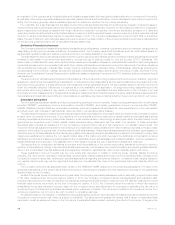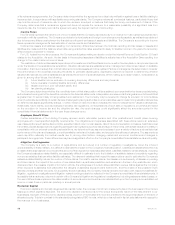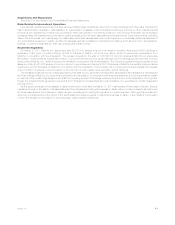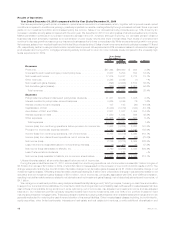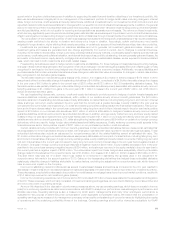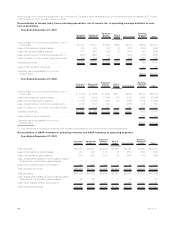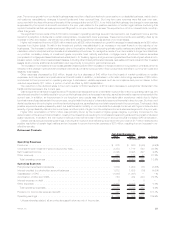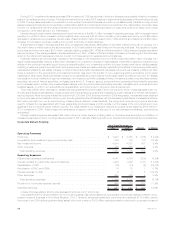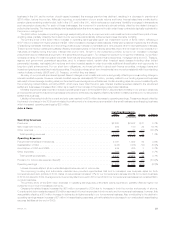MetLife 2010 Annual Report Download - page 18
Download and view the complete annual report
Please find page 18 of the 2010 MetLife annual report below. You can navigate through the pages in the report by either clicking on the pages listed below, or by using the keyword search tool below to find specific information within the annual report.$2.8 billion in 2009, whereas the increase in unrealized investment losses increased the DAC and VOBA balance by $3.4 billion in 2008.
Notes 3 and 6 of the Notes to the Consolidated Financial Statements include the DAC and VOBA offset to unrealized investment losses.
Goodwill
Goodwill is the excess of cost over the estimated fair value of net assets acquired. Goodwill is not amortized but is tested for impairment at
least annually or more frequently if events or circumstances, such as adverse changes in the business climate, indicate that there may be
justification for conducting an interim test.
Impairment testing is performed using the fair value approach, which requires the use of estimates and judgment, at the “reporting unit”
level. A reporting unit is the operating segment or a business one level below the operating segment, if discrete financial information is
prepared and regularly reviewed by management at that level.
For purposes of goodwill impairment testing, if the carrying value of a reporting unit exceeds its estimated fair value, there might be an
indication of impairment. In such instances, the implied fair value of the goodwill is determined in the same manner as the amount of goodwill
that would be determined in a business acquisition. The excess of the carrying value of goodwill over the implied fair value of goodwill would
be recognized as an impairment and recorded as a charge against net income.
The key inputs, judgments and assumptions necessary in determining estimated fair value of the reporting units include projected
operating earnings, current book value (with and without accumulated other comprehensive income), the level of economic capital required to
support the mix of business, long-term growth rates, comparative market multiples, the account value of in-force business, projections of new
and renewal business, as well as margins on such business, the level of interest rates, credit spreads, equity market levels, and the discount
rate that we believe is appropriate for the respective reporting unit. The estimated fair values of the retirement products and individual life
reporting units are particularly sensitive to the equity market levels.
We apply significant judgment when determining the estimated fair value of our reporting units and when assessing the relationship of
market capitalization to the aggregate estimated fair value of our reporting units. The valuation methodologies utilized are subject to key
judgments and assumptions that are sensitive to change. Estimates of fair value are inherently uncertain and represent only management’s
reasonable expectation regarding future developments. These estimates and the judgments and assumptions upon which the estimates are
based will, in all likelihood, differ in some respects from actual future results. Declines in the estimated fair value of our reporting units could
result in goodwill impairments in future periods which could materially adversely affect our results of operations or financial position.
On an ongoing basis, we evaluate potential triggering events that may affect the estimated fair value of our reporting units to assess
whether any goodwill impairment exists. Deteriorating or adverse market conditions for certain reporting units may have a significant impact
on the estimated fair value of these reporting units and could result in future impairments of goodwill.
Liability for Future Policy Benefits
The Company establishes liabilities for amounts payable under insurance policies, including traditional life insurance, traditional annuities,
certain accident and health, and non-medical health insurance. Generally, amounts are payable over an extended period of time and related
liabilities are calculated as the present value of future expected benefits to be paid reduced by the present value of future expected premiums.
Such liabilities are established based on methods and underlying assumptions in accordance with GAAP and applicable actuarial standards.
Principal assumptions used in the establishment of liabilities for future policy benefits are mortality, morbidity, policy lapse, renewal,
retirement, disability incidence, disability terminations, investment returns, inflation, expenses and other contingent events as appropriate to
the respective product type and geographical area. These assumptions are established at the time the policy is issued and are intended to
estimate the experience for the period the policy benefits are payable. Utilizing these assumptions, liabilities are established on a block of
business basis. If experience is less favorable than assumptions, additional liabilities may be required, resulting in a charge to policyholder
benefits and claims.
Future policy benefit liabilities for disabled lives are estimated using the present value of benefits method and experience assumptions as
to claim terminations, expenses and interest.
Liabilities for unpaid claims and claim expenses for property and casualty insurance are included in future policyholder benefits and
represent the amount estimated for claims that have been reported but not settled and claims incurred but not reported. Other policy-related
balances include claims that have been reported but not settled and claims incurred but not reported on life and non-medical health
insurance. Liabilities for unpaid claims are estimated based upon the Company’s historical experience and other actuarial assumptions that
consider the effects of current developments, anticipated trends and risk management programs, reduced for anticipated salvage and
subrogation.
Future policy benefit liabilities for minimum death and income benefit guarantees relating to certain annuity contracts and secondary and
paid-up guarantees relating to certain life policies are based on estimates of the expected value of benefits in excess of the projected account
balance and recognizing the excess ratably over the accumulation period based on total expected assessments. Liabilities for universal and
variable life secondary guarantees and paid-up guarantees are determined by estimating the expected value of death benefits payable when
the account balance is projected to be zero and recognizing those benefits ratably over the accumulation period based on total expected
assessments. The assumptions used in estimating these liabilities are consistent with those used for amortizing DAC, and are thus subject to
the same variability and risk. The assumptions of investment performance and volatility for variable products are consistent with historical
experience of the appropriate underlying equity index, such as the Standard & Poor’s Ratings Services (“S&P”) 500 Index.
The Company periodically reviews its estimates of actuarial liabilities for future policy benefits and compares them with its actual
experience. Differences between actual experience and the assumptions used in pricing of these policies and guarantees and in the
establishment of the related liabilities result in variances in profit and could result in losses.
Reinsurance
The Company enters into reinsurance agreements primarily as a purchaser of reinsurance for its various insurance products and also as a
provider of reinsurance for some insurance products issued by third parties. Accounting for reinsurance requires extensive use of
assumptions and estimates, particularly related to the future performance of the underlying business and the potential impact of counterparty
credit risks. The Company periodically reviews actual and anticipated experience compared to the aforementioned assumptions used to
establish assets and liabilities relating to ceded and assumed reinsurance and evaluates the financial strength of counterparties to its
reinsurance agreements using criteria similar to that evaluated in the security impairment process discussed previously. Additionally, for each
15MetLife, Inc.


